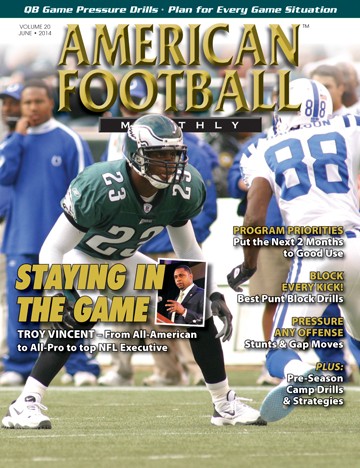Article CategoriesAFM Magazine
|
Safety First: Concussion Management and Return-to-Play Protocolby: Dr. James Kinderknecht© More from this issue It’s no secret that concussions are one of the biggest issues in football. According to The Center for Disease Control, 1.6 to 3.8 million concussions occur annually in sports and recreational activities, making it an important public health issue. Unfortunately, as more high-profile athletes fall victim to concussions and as the number of concussions in football continues to rise, larger amounts of misinformation about proper prevention methods and return-to-play protocol spread. It’s important to understand the facts when it comes to concussion management. Mistreatment of concussions can lead to greater injuries, such as permanent brain damage or even death. The younger the athlete, the greater the risk, so it’s important for parents and coaches to learn the proper protocol and not get absorbed in the misconceptions regarding return-to-play guidelines. A concussion, by definition, is a traumatically induced alteration in brain function manifested by alteration in awareness and various signs and symptoms, such as headache, vertigo, hearing loss, and/or fatigue. They are caused either by a direct blow to the head, face or neck, or elsewhere on the body with an impulsive force transmitted to the head. When faced with a concussion, either as a player, coach, or parent, there are several important things to keep in mind: USA Football has undertaken a nationwide initiative to help youth football coaches make the game safer through concussion education and awareness and the introduction of proper technique in their “Heads Up” program. Coaches everywhere are more concerned about player safety and more aware of methods that can help reduce, if not eliminate, concussions. Understand the difference between cognitive and absolute rest. Recent guidelines by the American Academy of Pediatrics outline the role of cognitive rest, stating that sometimes a temporary leave of absence from school, shortening of the school day, reduction of workload, and/or an allowance of more time to complete assignments or take tests may be necessary. However, absolute rest (no activity) longer than three days is usually not helpful and light aerobic exercise without contact has been shown to be helpful in individuals slow to recover. Resting for too long of a period can potentially lead to unwanted side effects such as depression, insomnia, and deconditioning. Reintegration into cognitive and physical activity should be gradual based on each individual’s condition with frequent monitoring. |
|
| HOME |
MAGAZINE |
SUBSCRIBE | ONLINE COLUMNISTS | COACHING VIDEOS |
Copyright 2025, AmericanFootballMonthly.com
All Rights Reserved




